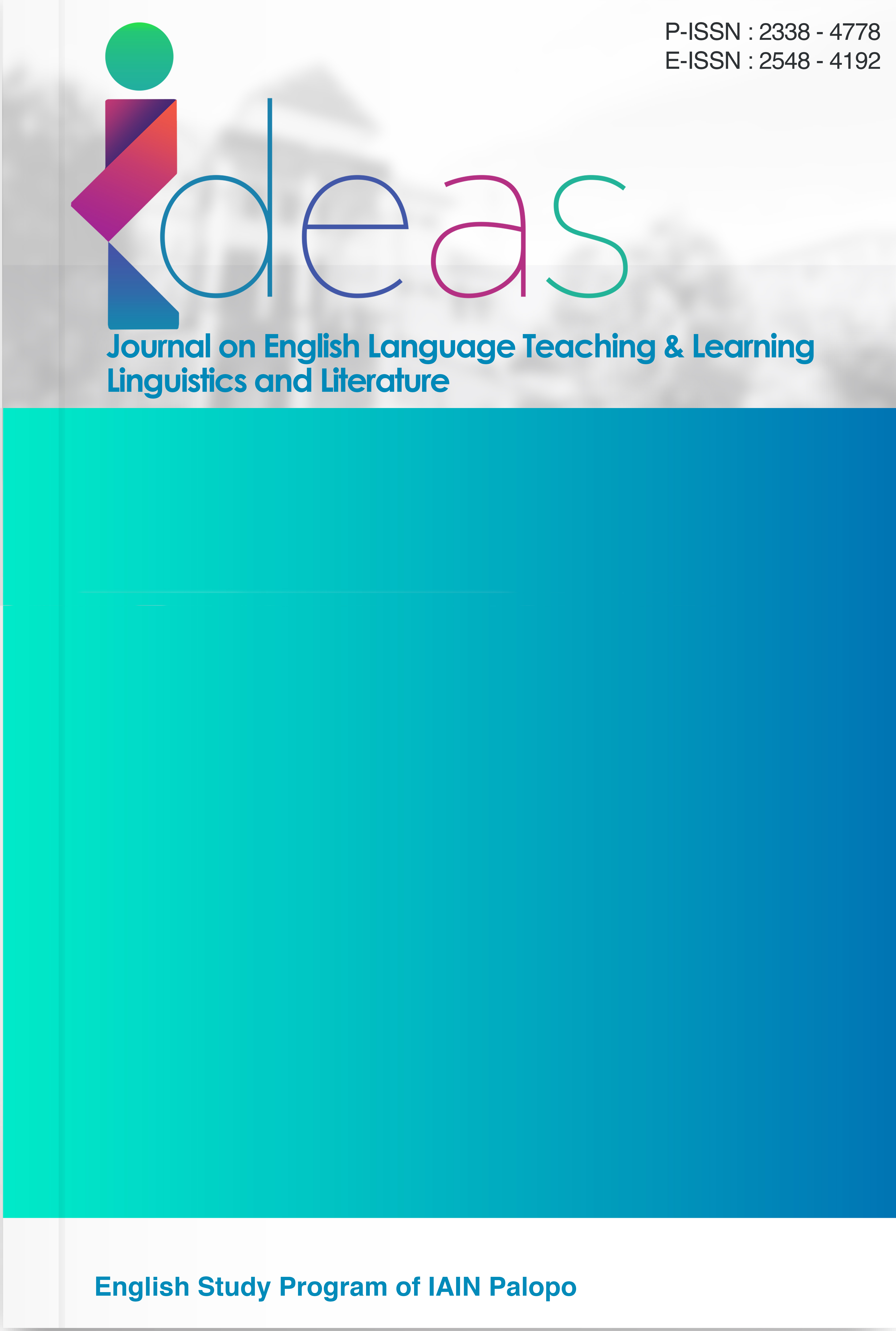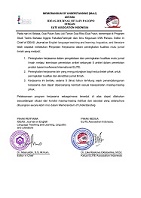Teachers’ Speech Acts on Students’ Engagement in Indonesian EFL Classrooms
DOI:
https://doi.org/10.24256/ideas.v13i2.6269Keywords:
Preferences, Speech acts, students' engagementAbstract
Strategic use of teacher’s language in the classroom has been acknowledged to play pivotal role in shaping the extent of students’ engagement. Despite extensive research on the subject, a limited understanding remains on the potential’s mismatch between teacher’s practice and students’ preference. This study examines how specific teacher’s speech acts, as a part of teacher’s language, influence Indonesian EFL students’ engagement and investigates which types of speech acts students perceive as most engaging. To achieve the objectives, the study collected the data through video-taped observations and a close-ended 20-item questionnaire administered to 47 junior high school students in Garut. The findings show that the teacher’s speech acts, particularly Directives, Assertives, and Expressives, exert substantial influence on the students’ behavioral, cognitive, and emotional engagement. Notably, despite the prominent role of those speech acts in fostering engagement during classroom interaction, students' self-reported preferences through questionnaires indicated that Expressives and Declarations were perceived as the most engaging. This discrepancy suggests that while teachers predominantly use instructional speech acts (e.g., Directives and Assertives), students exhibit a stronger affinity to Expressives and Declarations, which often incorporate elements of emotional connection, motivation, and humor. These findings reinforce the necessity for a balanced and dynamic pedagogical approach in EFL settings, by integrating various speech acts to optimize students’ engagement.
References
Adams, M. (2009). Power, Politeness, and the Pragmatics of Nicknames. 57(2), 81–91. https://doi.org/10.1179/175622709X436369
AlAfnan, M. A. (2022). Uniting for Peace: A Speech Act Analysis of the United Nations General Assembly Resolution 377 A (V). World Journal of English Language, 12(6), 50–58. https://doi.org/10.5430/wjel.v12n6p50
Amir, N. (2023). THE IMPACTS OF SPEECH ACTS ON THE EFL TEACHER AND THE STUDENTS ACTIVENESS IN THE TEACHING-LEARNING PROCESS. Ekspose: Jurnal Penelitian Hukum dan Pendidikan, 22(2), 1-16.
Anisah, L., Zuriyati, & Anwar, M. (2023). Speech Acts Used by the English Teacher in the EFL Classroom. Jurnal Pendidikan Tambusai, 7(3), 26351–26361.
Arbain, A., Gunawan, F., Al Haddar, G., & Sitinjak, C. (2024). Commanding and Requesting: Teachers’ Speech Acts in Indonesian Vocational English Schools. Forum for Linguistic Studies, 6(5), 678–697. https://doi.org/10.30564/fls.v6i5.6989
Arifah, N., Salija, K., & Abdullah, A. (2024). Speech Act Analysis of Teacher Talk in EFL Classroom. ARRUS Journal of Social Sciences and Humanities, 4(2), 232–240. https://doi.org/10.35877/soshum2524
Austin, J. L. (1975). HOW TO DO THINGS WITH WORDS. Harvard University Press. https://doi.org/10.14361/9783839429693-021
Azizah, S. P. N., Nurpadilah, S. D., Noerbayani, P., & Rahmawati, D. (2023). The Contribution of Teacher Talk on Student Engagement in English Classroom. 02(01), 165–176.
Basra, S. M., & Thoyyibah, L. (2017). A Speech Act Analysis of Teacher Talk in an EFL Classroom. International Journal of Education, 10(1), 73. https://doi.org/10.17509/ije.v10i1.6848
Beaver, D., & von Fintel, K. (2007). Semantics and Pragmatics—A New Journal. Semantics and Pragmatics, 0, 1–15. https://doi.org/10.3765/sp.0.1
Blum-Kulka, S. (1987). Indirectness and politeness in requests: Same or different? Journal of Pragmatics, 11(2), 131–146. https://doi.org/10.1016/0378-2166(87)90192-5
Connell, J. P., & Wellborn, J. G. (1991). Competence, autonomy, and relatedness: A motivational analysis of self-system processes.
Darong, H. C. (2024). Conversational Analysis: Types and Function of Speech Acts in EFL Classroom Interactions. Journal of Languages and Language Teaching, 12(3), 1191. https://doi.org/10.33394/jollt.v12i3.11001
Djema, S., & Toumi, K. (2021). The Role of Teachers’ Illocutionary Acts in Improving Learners’ Motivation in EFL: An Analysis of Third-Year Teachers’ and Learners’ Views at Hammadi Mohand and Krim Belkacem Secondary Schools (Doctoral dissertation, Mouloud Mammeri University of Tizi-Ouzou).
Fredricks, J. A., Blumenfeld, P. C., & Paris, A. H. (2004). School engagement: Potential of the concept, state of the evidence. Review of Educational Research, 74(1), 59–109. https://doi.org/10.3102/00346543074001059
Han, K. (2021). Fostering Students’ Autonomy and Engagement in EFL Classroom Through Proximal Classroom Factors: Autonomy-Supportive Behaviors and Student-Teacher Relationships. Frontiers in Psychology, 12(October), 1–7. https://doi.org/10.3389/fpsyg.2021.767079
Harris, L. R., & Brown, G. T. L. (2010). Mixing interview and questionnaire methods: Practical problems in aligning data. Practical Assessment, Research and Evaluation, 15(1).
Hidayat, D. N., Fadhilah, F., & Septiawan, Y. (2022). Speech acts in an English classroom: A case at a junior high school in Indonesia. EduLite: Journal of English Education, Literature and Culture, 7(2), 251. https://doi.org/10.30659/e.7.2.251-265
Hsieh, H. F., & Shannon, S. E. (2005). Three approaches to qualitative content analysis. Qualitative Health Research, 15(9), 1277–1288. https://doi.org/10.1177/1049732305276687
Iksan, M., Husnaini, H., & Masruddin, M. (2022). Implementation of a weekly English program with a fun learning method for Pesantren students. Ethical Lingua: Journal of Language Teaching and Literature, 9(2), 872-879.
Husnaini, H., & Sompa, S. R. (2025, June). Using the Speechway Application to Increase Students Speaking Skills in the English Education Department at Iain Palopo. In Proceedings of the Third International Conference on English Language Education.
Immanuella, B. D. U., Kurniawati, F., & Rifameutia, T. (2023). Student Engagement Among Undergraduate Students in Southeast Asia: A Systematic Literature Review. Journal of Innovation in Educational and Cultural Research, 4(4), 602–615. https://doi.org/10.46843/jiecr.v4i4.961
Iswani, I. N., Syarief, J., & Bukhori, D. N. (2024). Automatically Muted: Navigating Speaking Challenges Among University Students in a Collectivist Culture. Proceeding Seminar Nasional Mahasiswa Sosiologi, 2(2), 376–390.
Ivankova, N., & Creswell, J. (2009). Mixed methods. In Qualitative Research in Applied Linguistics: A Practical Introduction (p. 135).
Izar, J., Nasution, M. M., Afria, R., Harianto, N., & Sholiha, M. (2021). Expressive Speech Act in Comic Bintang Emon’s Speech in Social Media about Social Distancing. Titian: Jurnal Ilmu Humaniora, 5(1), 148–158. https://doi.org/10.22437/titian.v5i1.13100
Karunarathna, I., Gunasena, P., Hapuarachchi, T., Ekanayake, U., Rajapaksha, S., Gunawardana, K., & Aluthge, P. (2024). Comprehensive Data Collection: Methods, Challenges, and the Importance of Accuracy. Uva Clinical Research, 1–24.
Lane, K., Menzies, H., Bruhn, A., & Crnobori, M. (2011). Managing Challenging Behaviors in Schools. in Behaviors in Schools (pp. 1–9). Guilford Press.
Liu, M., Noordin, N., Ismail, L., & Abdrahim, N. A. (2023). Relationship between Student Engagement and Academic Achievement in College English Education for Non-English Majors in China. International Journal of Learning, Teaching and Educational Research, 22(8), 203–232. https://doi.org/10.26803/IJLTER.22.8.12
Langi, N. T. (2024). Using a Picture of a Luwu Culture Activity for Teaching Vocabulary. English Language Teaching Methodology, 4(3), 482-488.
Liu, T., & Mantuhac, P. B. (2024). Teacher Support and Student Engagement in the Conduct of Blended Learning Instruction for English as a Foreign Language. 11(2).
Migiro, S. O., & Magangi, B. A. (2011). Mixed methods: A review of literature and the future of the new research paradigm. African Journal of Business Management, 5(10), 3757–3764. https://doi.org/10.5897/AJBM09.082
Nababan, G., Purba, J. E. L., & Aji, K. A. (2021). Mengukur keterlibatan siswa kelas VII di sekolah ABC dalam pembelajaran matematika online. Jurnal Magister Pendidikan Matematika (JUMADIKA), 3(2), 100-109.
Masruddin, M., & Abduh, N. K. (2024, May). Indonesian Language Learning for Foreign Speakers Based on Luwu Culture: A Needs Analysis Study. In 4th International Conference on Linguistics and Culture (ICLC-4 2023) (pp. 75-80).
Putra, D. A., & Tressyalina. (2024). GENDER REPRESENTATION IN DIRECTIVE SPEECH ACTS OF TEACHERS: A Study on Indonesian Language Learning in Automotive Vocational High Schools. JOLLT Journal of Languages and Language Teaching, 12(2), 1038–1047.
Santosa, A. W., & Kurniadi, A. (2020). SPEECH ACT ANALYSIS OF TEACHER TALK IN EFL CLASSROOM. Jurnal Penelitian Humaniora, 21(2), 101–107. https://doi.org/10.35877/soshum2524
Searle, J. R. (1976). A classification of illocutionary acts. Language in Society, 5(1), 1–23. https://doi.org/10.1017/S0047404500006837
Sharma, H. (2022). How short or long should a questionnaire be for any research? Researchers dilemma in deciding the appropriate questionnaire length. Saudi Journal of Anaesthesia, 16(1), 65–68. https://doi.org/10.4103/sja.sja_163_21
Skinner, E. A., & Belmont, M. J. (1993). Motivation in the Classroom: Reciprocal Effects of Teacher Behavior and Student Engagement Across the School Year. Journal of Educational Psychology, 85(4), 571–581.
Thanh, T. N. (2024). Analyzing student engagement in teacher elicitation: A retrospective discourse analysis in a Vietnamese EFL speaking class. Addressing Issues of Learner Diversity in English Language Education, 78–97. https://doi.org/10.4018/979-8-3693-2623-7.ch005
Waloyo, E., Lestari, S., & Mutiaraningrum, I. (2023). Exploring Studies on Cooperative Principle in English Language Teaching: A Literature Review. Metathesis: Journal of English Language, Literature, and Teaching, 7(1), 17–30. https://doi.org/10.31002/metathesis.v7i1.157
Yanti, D. R., Amin, M., & Amarullah. (2021). The analysis of speech acts used by EFL teachers ’in classroom interaction at SMAN 2 Mataram in the academic year 2021/2022. International Journal of Multicultural and Multireligious Understanding, 8(5), 90–98.
Yu, M., Wang, H., & Xia, G. (2022). The Review on the Role of Ambiguity of Tolerance and Resilience on Students’ Engagement. Frontiers in Psychology, 12(January), 1–7. https://doi.org/10.3389/fpsyg.2021.828894
Zhanibekova, S. (2024). Speech Act Theory in Teaching Language to Adults Supervisor. Universita Ca’Foscari Venezia.
Zheng, F. (2022). Fostering Students’ Well-Being: The Mediating Role of Teacher Interpersonal Behavior and Student-Teacher Relationships. Frontiers in Psychology, 12(January). https://doi.org/10.3389/fpsyg.2021.796728
Zulianti, H. (2018). Speech Acts on EFL Learners’ Teaching Performance. Jurnal SMART: Journal of English Language Teaching and Applied Linguistics, 4(2), 93–106. https://doi.org/10.26638/js.693.203X
Downloads
Published
Issue
Section
Citation Check
License
Copyright (c) 2025 Sinta Dewi, Virna Alfiqa Sopwani, Agis Aeni

This work is licensed under a Creative Commons Attribution-ShareAlike 4.0 International License.
Authors retain copyright and grant the journal right of first publication with the work simultaneously licensed under an Attribution-ShareAlike 4.0 International (CC BY-SA 4.0) that allows others to share the work with an acknowledgement of the work's authorship and initial publication in this journal.
Authors are able to enter into separate, additional contractual arrangements for the non-exclusive distribution of the journal's published version of the work (e.g., post it to an institutional repository or publish it in a book), with an acknowledgement of its initial publication in this journal.
Authors are permitted and encouraged to post their work online (e.g., in institutional repositories or on their website) prior to and during the submission process, as it can lead to productive exchanges, as well as earlier and greater citation of published work (See the Effect of Open Access)




